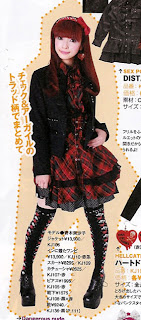Visual Kei is a fashion trend amongst many Japanese musicians (usually rockers). This style is distinguished by the make-up, exaggerated hairstyles and flamboyant costumes. Some people say that Visual Kei refers to a music genre, or a sub-genre of Japanese rock (J-rock) related to glam-rock, punk rock, Gothic rock and metal. But the participation in the sub-culture of Visual Kei fashion is just as important as the music.
This Visual Kei style started in the late 1980's with bands such as X Japan and Color. The term Visual Kei was created with one of X Japan's slogans "Psychedelic violence crime of visual shock".
Visual Kei has enjoyed popularity among artists achieving mainstream success, with influences from Western phenomena, such as glam, goth and cyberpunk. The popularity and awareness of such groups outside of Japan has seen an increase in recent years.
Some examples of Visual Kei bands are:
Malice Mizer
Ayabie
AnCafe
There are many influences from different time periods in visual kei. My favourite amongst the visual kei j-rock bands is Versailles, who are easily recognized by their Victorian/rococo-esque costumes and theme. The band members look flawless and beautiful as a result to their makeup and goes well with their beautiful clothing. They have a 'princely' and 'princessy' feel to them (the guitarist Hizaki and deceased guitarist Jasmine You cross dressed as girls). Not only do I think that there image as a band is attractive, but their music also is very attractive. I also find it funny when in the music videos with a Victorian house and setting, you see an rich, elegant and beautiful looking girl and boy sitting in chairs playing electric guitars/bass.
































